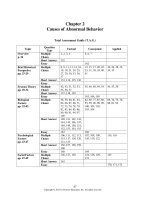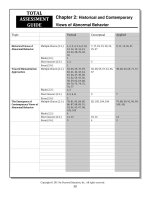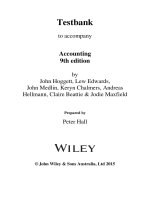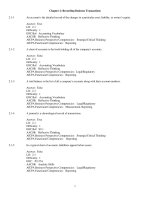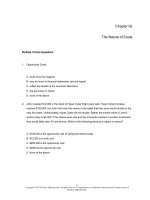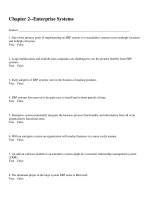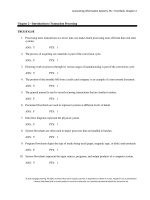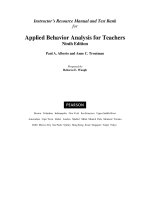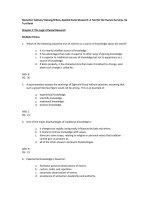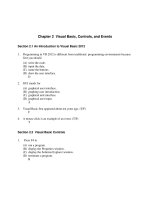Research methods in psychology 9th edition shaughnessy test bank
Bạn đang xem bản rút gọn của tài liệu. Xem và tải ngay bản đầy đủ của tài liệu tại đây (287.42 KB, 23 trang )
02
Student: ___________________________________________________________________________
1.
How is the empirical approach that is used in the scientific method different from a nonscientific
(everyday) approach to knowledge?
2.
Distinguish between the accuracy of a measuring instrument and the validity of the measurement
resulting from the use of the instrument.
3.
Distinguish between the nomothetic approach and the idiographic approach in descriptions of
psychological phenomena.
4.
Explain how an experiment is used to understand the cause of a phenomenon by describing the three
conditions for causal inference an experiment meets.
5.
Describe the differences between basic and applied research.
6.
Which of the following is a characteristic of the scientific method?
A. biased reporting
B. uncontrolled observation
C. unreliable measurement
D. testable hypotheses
7.
Which of the following is a cognitive bias that can interfere with our ability to consider evidence
appropriately because we perceive a relationship when none exists?
A. illusory correlation
B. covariation
C. spurious relationship
D. perceptual set
8.
The essential ingredient of scientific observation is
A. precise instrumentation.
B. description.
C. control.
D. application.
9.
As an approach to knowledge, the scientific method relies on
A. intuitive procedures.
B. empirical procedures.
C. subjective procedures.
D. deductive procedures.
10. The empirical approach used in the scientific method is based on
A. illusory correlation and application.
B. intuition followed by inference.
C. direct observation and experimentation.
D. legal rules of evidence.
11. The primary means that scientists use to establish control in their observations is to
A. train multiple observers.
B. manipulate an independent variable in an experiment.
C. establish the accuracy and precision of their measurements.
D. observe many dependent variables.
12. Based on investigations with the horse Clever Hans, an important factor researchers should seek to
control when testing whether dogs can sniff cancer in urine samples is
A. whether the dogs are tested indoors or outdoors.
B. whether, during testing, the dogs can see people who know which samples came from cancer patients.
C. that the urine samples should all come from a diverse group of patients.
D. that some samples should come from people and some from horses.
13. The factors that the researcher controls or manipulates in order to determine their effect on behavior are
called the
A. relevant variables.
B. dependent variables.
C. intervening variables.
D. independent variables.
14. In a study investigating the effects of two different types of music on students' test performance, the
music represents the
A. dependent variable.
B. intervening variable.
C. independent variable.
D. criterion variable.
15. In an experiment that compares aggressive responses following exposure to media violence in television
programming, "aggressive responses" is the __________ and "exposure to media violence" is the
__________.
A. dependent variable; independent variable
B. independent variable; dependent variable
C. construct; operational definition
D. operational definition; construct
16. In a study examining the number of proofreading errors made when students are tested while reading
under bright or dim lighting, the number of proofreading errors represents the
A. dependent variable.
B. independent variable.
C. control variable.
D. individual differences variable.
17. When scientists report their findings they strive to describe
A. only the aspects of what they have observed that differ from what they expected to observe.
B. only their personal interpretations.
C. only what they have observed.
D. what they have observed along with their personal interpretations.
18. If you describe that a small rodent "chewed" an index card and "ate" a cookie when what you observed in
these two situations was essentially the same, your report likely includes
A. contaminated observations.
B. illusory correlations.
C. distorted behaviors.
D. inferences.
19. Which of the following is an accepted check that scientists can use to determine whether a scientific
report is unbiased?
A. the precision of the data that are reported
B. parsimony of explanation
C. verification by more than one independent observer
D. the reputation of the scientist making the report
20. The term scientists use to refer to a psychological concept is
A. validity.
B. construct.
C. variability.
D. operational definition.
21. An operational definition of a construct is
A. reliable, because it is consistent.
B. valid, because it is truthful.
C. an intervening variable that connects independent and dependent variables.
D. a specific procedure for producing or measuring the construct.
22. When intelligence is defined by specifying a paper-and-pencil test emphasizing understanding of logical
relationships and familiarity with the meaning of words, intelligence is being defined with a(n)
A. operational definition.
B. hypothetical definition.
C. empirical definition.
D. construct definition.
23. Which of the following characteristics is most assured when scientists use operational definitions to
communicate?
A. uniqueness of a construct
B. meaningfulness
C. validity of measurement
D. clarity of meaning
24. One disadvantage that results from the use of operational definitions is that
A. the reliability and validity of the operational definition become equivalent.
B. there are far too many psychological constructs.
C. a potentially limitless number of operational definitions exists for any construct.
D. communication among scientists becomes confused.
25. A researcher calibrates an instrument by placing a five-pound weight on a scale to see if the scale gives a
reading of 5.0 pounds. The researcher is testing the scale's
A. reliability.
B. accuracy.
C. validity.
D. correlation.
26. A student has carefully selected the clock she will use to time the presentation of materials in her
experiment. She wants to be sure that she will be able to measure the times to within a hundredth of a
second rather than a tenth of a second. Which characteristic of the instrument is the student trying to
ensure?
A. validity
B. reliability
C. accuracy
D. precision
27. The main difference between physical measurement and psychological measurement is that physical
measurement
A. involves dimensions with agreed-upon standards and instruments.
B. requires multiple observers to assess agreement.
C. uses humans as the measurement instruments.
D. is quantitative and nomothetic.
28. When using psychological measurement of a dimension such as aggression, psychologists base their
measurements of people's aggressiveness on
A. consensus among researchers in the field of aggression as to the theoretical definition of aggression.
B. agreement among a number of observers regarding their ratings of behavior on an aggressiveness
scale.
C. consistency across operational definitions of aggression.
D. availability of a precise measuring instrument, preferably based on a physiological response.
29. A new measure of intelligence (e.g., how long people can balance a ball on their nose) would be a valid
measure of intelligence if scores on the new measure were
A. unrelated to scores on other accepted measures of intelligence.
B. more varied across people than scores on other accepted measures of intelligence.
C. related to scores on other accepted measures of intelligence.
D. more precise than scores on other accepted measures of intelligence.
30. Which of the following characteristics applies to a measurement that consistently discriminates between
high and low scorers on a test?
A. precision
B. validity
C. reliability
D. accuracy
31. An individual's score on a test such as the SAT represents how that person consistently performs on such
a test only if the SAT test is
A. reliable.
B. precise.
C. valid.
D. standardized.
32. Reliability refers to the ________ of measurement, and validity refers to the ________ of
measurement.
A. operational definition, objectivity
B. accuracy, precision
C. testability, parsimony
D. consistency, truthfulness
33. Researchers are more likely to achieve reliable observations when
A. two observers provide unique descriptions of an event.
B. two observers show agreement in their descriptions of an event.
C. one observer has spent a long time observing the same event.
D. one observer reports having observed a very unusual event.
34. The testable, tentative explanations scientists use to explain events are called
A. hypotheses.
B. postulates.
C. heuristics.
D. causal inferences.
35. The idea that people purchase "green" products in order to achieve higher status by behaving altruistically
is
A. a hypothesis.
B. a circular argument.
C. reliable and valid.
D. all of these
36. What characteristic distinguishes scientific hypotheses from casual, everyday hypotheses?
A. certainty
B. testability
C. intuitive appeal
D. circularity
37. A researcher's hypothesis predicts that people are more aggressive following exposure to media violence
because they find the violence disturbing. A potential problem with this hypothesis is
A. it appeals to forces not recognized by science.
B. the concept "disturbing" is not adequately defined.
C. it is circular: "aggression" and "disturbing" refer to the same thing.
D. all of these
38. Scientists would likely reject the hypothesis that a person was violent because the person was possessed
by the Devil. Scientists reject a hypothesis like this one not because it is inherently wrong, but because
the hypothesis lacks the necessary scientific characteristic of being
A. complex.
B. circular.
C. testable.
D. concise.
39. When an hypothesis is stated in such a way that the event to be explained becomes the explanation itself
(e.g., the child is distractable because he has attention deficit disorder), the hypothesis is said to be
A. inadequately defined.
B. appealing to forces not recognized by science.
C. circular.
D. redundant.
40. The four goals of research in psychology are
A. reliability, validity, experimentation, and theory construction.
B. description, correlation, experimentation, and theory construction.
C. description, prediction, explanation, and application.
D. observation, measurement, causal inference, and explanation.
41. The criteria used to classify and define mental disorders in the Diagnostic and Statistical Manual of
Mental Disorders represent an illustration of which of the following goals of the scientific method?
A. description
B. prediction
C. explanation
D. integration
42. Using the nomothetic approach, psychologists seek to
A. establish general laws of behavior that apply to a diverse population.
B. create change in an individual's life.
C. eliminate confoundings in their experiments.
D. describe one individual's behavior in relation to his or her environment.
43. A researcher asks a sample of 200 individuals to complete a questionnaire. She then computes statistics
such as means and standard deviations to describe how individuals respond in general. This researcher's
approach is
A. idiographic and qualitative.
B. idiographic and quantitative.
C. nomothetic and qualitative.
D. nomothetic and quantitative.
44. The nomothetic approach in psychology (or in any science) is intended to establish broad generalizations
and universal "laws." When using the nomothetic approach researchers are likely to make
A. many observations of one individual.
B. observations of many individuals and focus on extreme scores.
C. observations of many individuals and focus on the average (typical) score.
D. few observations of a few individuals and focus on the scores that occur most often.
45. Which of the following characterizes the majority of the research conducted in psychology?
A. qualitative research using the nomothetic approach
B. qualitative research using the idiographic approach
C. quantitative research using the nomothetic approach
D. quantitative research using the idiographic approach
46. When research consists of verbal summaries of "naturally occurring, ordinary events in natural settings"
the research is
A. equally likely to be qualitative or quantitative research.
B. more likely to be qualitative research than quantitative research.
C. more likely to be quantitative research than qualitative research.
D. unlikely to be either qualitative or quantitative research.
47. A correlational study is uniquely useful for meeting which of the following goals of the scientific
method?
A. description
B. prediction
C. explanation
D. application
48. A correlation exists when
A. two hypotheses are shown to support the same theory.
B. two independent variables are confounded.
C. a measurement is both reliable and valid.
D. two measures of the same people, events, or things vary together.
49. Research has indicated that amount of undergraduate research activity is a predictor of later success in
the profession of psychology. For this prediction to be possible, undergraduate research activity and later
success must be
A. circular.
B. qualitative.
C. causal.
D. correlated.
50. Correlations are valuable because they allow psychologists to
A. make predictions based on the way two variables covary.
B. create change in people's lives.
C. describe, predict, and understand the causes of psychological phenomena.
D. all of these
51. When researchers observe a correlation between two variables, such as between the amount of time spent
studying and test scores, they know that
A. the first variable causes the second variable.
B. the second variable causes the first variable.
C. both (A) and (B)
D. neither (A) nor (B)
52. Which of the following statements best describes the relationship between correlation and causation?
A. Correlation and causation are synonymous.
B. Correlation directly implies a causal inference.
C. Correlation does not imply causation.
D. Correlation is confounded with causation.
53. Researchers have shown that teacher evaluations based on brief viewings of videotapes made by students
who were not enrolled in a course correlate well with end-of-the-semester teacher evaluations made by
students enrolled in the class. The researchers suggest that the relationship occurs because people are
attuned to pick up information about a person's affect quickly because this information is adaptive. Based
on the correlational evidence alone, the researchers' explanation for their findings can best be considered
a
A. causal inference.
B. speculation.
C. sound conclusion.
D. confirmed hypothesis.
54. Psychologists use _______ to identify the causes of a phenomenon.
A. correlations
B. qualitative research
C. controlled experiments
D. operational definitions
55. A(n) ____________ is a statement about the cause of an event or behavior.
A. causal inference
B. experiment
C. construct
D. correlation
56. Which of the following is not one of the conditions for making a causal inference?
A. covariation of events
B. a time-order relationship
C. elimination of plausible alternative causes
D. confounding of variables
57. If a researcher wants to do a study to show that active learning strategies help students learn she
should
Amanipulate teaching strategies by having one group assigned to work with active learning strategies and
. a second group assigned to work with strategies that did not involve active learning and see if students'
performance covaries with the teaching method.
Bhave one teacher teach one group of students with active learning strategies and have a different teacher
. teach a second group of students with a method that did not use active learning strategies, then compare
the performance of the two groups.
Chave students choose to learn either using active learning strategies or using methods that did not use
. active learning strategies and then compare the performance of the two groups of students.
D.teach one group of students with the active learning strategies and describe the students' performance
based on her observations.
58. The research goal of "prediction" is most associated with _____ research, and the research goal
of "explanation" is most associated with _____ research.
A. applied, basic
B. multimethod, single method
C. correlational, experimental
D. nomothetic, idiographic
59. When two potentially effective independent variables are allowed to covary simultaneously, a
__________ has occurred.
A. covariation
B. correlation
C. confounding
D. causal inference
60. A researcher wanted to compare the relative effectiveness of two techniques for reducing anxiety: a drug
and a relaxation exercise. The researcher gave the experimental group both the drug and the relaxation
exercise. The control group was given neither the drug nor the exercise. The difference between the drug
and the relaxation exercise cannot be compared in this experiment because the experiment involves a
A. redundant relationship.
B. confounding.
C. causal inference.
D. correlation.
61. A researcher is interested in testing the effectiveness of a new approach to leading discussion groups in
his classes. He assigns all the females in one of his classes to use the new discussion method and all the
males to use the old discussion method. The researcher will not be able to interpret the results because his
study is flawed due to
A. his having limited the boundary of generalizing his results.
B. the fact that he tested only one of his classes.
C. his failure to manipulate an independent variable.
D. the confounding of gender and discussion method.
62. When scientists conduct research they seek to
A. generalize their findings beyond the people and circumstances used in their study.
B. describe only the findings for people and circumstances who participated in their study.
C. use only real-world settings.
D. use only laboratory settings.
63. Psychological scientists believe that
A. only research conducted in laboratories is important.
B. only research conducted in real-world settings is important.
C. both research conducted in laboratories or in real-world settings is important.
D. research findings are valid only if they have been observed both in laboratories and in real-world
settings.
64. Research that is conducted with the goal of understanding phenomena and testing a theory is referred to
as __________ research.
A. correlational
B. basic
C. applied
D. idiographic
65. The widespread application of psychological principles in our everyday life is possible because of
_________ in the past.
A. basic research
B. time-order relationships
C. idiographic research
D. intervening variables
66. Which of the following statements about research in psychology is true?
A. All research in psychology involves experiments.
B. Psychologists view basic research and applied research as complementary.
C. Researchers observe correlations between variables to make causal inferences about behavior.
D. All of these
67. The greater the scope of a theory the more complex it is likely to be. Complexity is
A. a necessary characteristic of psychological theories given the nature and range of phenomena
psychologists try to understand.
B. a serious obstacle to testing a theory.
C. both a necessary characteristic of psychological theories and a serious obstacle to testing a theory.
D. none of these
68. A(n) __________ is a logically organized set of propositions that serves to define events, describe
relationships among events, and explain the occurrence of events.
A. hypothesis
B. intervening variable
C. theory
D. causal inference
69. The major function of a theory in psychology is to
A. develop quantitative and qualitative predictions for the results of future experiments.
B. derive explanations that are independent of the results of experiments.
C. formulate definitive explanations for empirical findings.
D. organize empirical knowledge and guide research.
70. Theorists propose _______ variables to connect independent and dependent variables and explain why
these variables are connected.
A. hypothetical
B. intervening
C. confounding
D. operational
71. A researcher manipulates the amount of time participants view a list of words (1 vs. 4 minutes), and
measures the number of words the participants are able to write down 10 minutes later. The researcher
suggests that in-between the presentation time and the later recall of the words, the words are in
participants' memory. The construct of "memory" in this example represents
A. an operational definition.
B. the researcher's independent variable.
C. the researcher's dependent variable.
D. an intervening variable.
72. Of the following, the best description of "intervening variables" in psychology is that
A. they are constructs that unite a wide variety of apparently dissimilar variables.
B. they are obstacles in successful theory construction and testing.
C. there are very few intervening variables in psychology.
D. they rarely are of use when psychologists try to explain why variables are related.
73. When constructing and evaluating a theory, scientists follow a guideline that places a premium on
identifying the simplest of alternative explanations of a phenomenon. This guideline is called the
A. test of empirical verification.
B. rule of parsimony.
C. criterion of precision of prediction.
D. law of least error.
74. A theory that predicts children will develop abstract reasoning by age 12 is more ________ than a theory
that predicts the development of abstract reasoning by ages 12 to 20.
A. parsimonious
B. general
C. precise
D. hypothetical
75. The most rigorous test of a scientific theory involves
A. precision of prediction.
B. generalization.
C. the rule of parsimony.
D. falsification.
76. A researcher conducted two experiments to test a theory. One experiment was designed to confirm a
hypothesis of the theory and the second experiment was designed to falsify the hypothesis. From the
perspective of theory construction and testing,
A. the theory is precise and parsimonious.
B. the theory is neither precise nor parsimonious.
C. the first experiment is more informative.
D. the second experiment is more informative.
02 Key
1.
(p. 29-30)
How is the empirical approach that is used in the scientific method different from a nonscientific
(everyday) approach to knowledge?
The empirical approach involves the use of evidence based on direct observation and experimentation
to determine what is true. A nonscientific (everyday) approach relies primarily on intuition to decide
what is true.
Level: Factual
Shaughnessy - Chapter 02 #1
2.
(p. 36, 38)
Distinguish between the accuracy of a measuring instrument and the validity of the measurement
resulting from the use of the instrument.
The accuracy of the measuring instrument is determined by calibrating or checking it with another
instrument known to produce true values (e.g., determining the accuracy of a speedometer by
using roadside markers and a watch). The validity of the measurement resulting from the use of an
instrument depends on whether the measure is truthful, that is, whether it measures what it claims to
measure.
Level: Factual
Shaughnessy - Chapter 02 #2
3.
(p. 42-43)
Distinguish between the nomothetic approach and the idiographic approach in descriptions of
psychological phenomena.
The nomothetic approach is used to seek broad generalizations and universal laws (i.e., what "in
general" is true) by studying large numbers of participants of a group and focusing on the "average"
performance of the group. The idiographic approach is used to focus on the uniqueness of the
individual by studying an individual intensively using a procedure such as the case study method.
Level: Factual
Shaughnessy - Chapter 02 #3
4.
(p. 46-48)
Explain how an experiment is used to understand the cause of a phenomenon by describing the three
conditions for causal inference an experiment meets.
Researchers conduct an experiment when they manipulate an independent variable and observe the
effects of the manipulation on a dependent variable measure. When differences on the dependent
variable measure are observed for the conditions of the independent variable, covariation is
met (i.e., different scores on the dependent variable covary with different conditions of the
independent variable). In addition, because differences on the dependent variable are observed
after the independent variable manipulation, the second condition for causal inference—time-order
relationship—is met. When the experiment is free of confoundings the researcher is able to eliminate
alternative explanations for the outcome, the third condition for causal inference.
Level: Conceptual
Shaughnessy - Chapter 02 #4
5.
Describe the differences between basic and applied research.
(p. 49)
In basic research the research psychologist seeks primarily to understand behavior and mental
processes. Basic research is typically carried out in a laboratory using controlled experiments and is
usually done with the goal of testing a theory about behavior. It is, in a sense, "seeking knowledge for
its own sake." Applied research is conducted in order to improve people's lives and often is carried out
in nonlaboratory settings (e.g., schools, workplaces). Applied research often builds upon findings from
basic research; these findings are applied in natural settings with the scientific goal of creating change.
Level: Factual
Shaughnessy - Chapter 02 #5
6.
(p. 28)
Which of the following is a characteristic of the scientific method?
A. biased reporting
B. uncontrolled observation
C. unreliable measurement
D. testable hypotheses
Level: Conceptual
Shaughnessy - Chapter 02 #6
7.
(p. 29)
Which of the following is a cognitive bias that can interfere with our ability to consider evidence
appropriately because we perceive a relationship when none exists?
A. illusory correlation
B. covariation
C. spurious relationship
D. perceptual set
Level: Factual
Shaughnessy - Chapter 02 #7
8.
(p. 30)
The essential ingredient of scientific observation is
A. precise instrumentation.
B. description.
C. control.
D. application.
Level: Factual
Shaughnessy - Chapter 02 #8
9.
(p. 30)
As an approach to knowledge, the scientific method relies on
A. intuitive procedures.
B. empirical procedures.
C. subjective procedures.
D. deductive procedures.
Level: Factual
Shaughnessy - Chapter 02 #9
10.
(p. 30)
The empirical approach used in the scientific method is based on
A. illusory correlation and application.
B. intuition followed by inference.
C. direct observation and experimentation.
D. legal rules of evidence.
Level: Factual
Shaughnessy - Chapter 02 #10
11.
(p. 30-32)
The primary means that scientists use to establish control in their observations is to
A. train multiple observers.
B. manipulate an independent variable in an experiment.
C. establish the accuracy and precision of their measurements.
D. observe many dependent variables.
Level: Factual
Shaughnessy - Chapter 02 #11
12.
(p. 31-32)
Based on investigations with the horse Clever Hans, an important factor researchers should seek to
control when testing whether dogs can sniff cancer in urine samples is
A. whether the dogs are tested indoors or outdoors.
B. whether, during testing, the dogs can see people who know which samples came from cancer
patients.
C. that the urine samples should all come from a diverse group of patients.
D. that some samples should come from people and some from horses.
Level: Conceptual
Shaughnessy - Chapter 02 #12
13.
(p. 31-32)
The factors that the researcher controls or manipulates in order to determine their effect on behavior
are called the
A. relevant variables.
B. dependent variables.
C. intervening variables.
D. independent variables.
Level: Factual
Shaughnessy - Chapter 02 #13
14.
(p. 32-33)
In a study investigating the effects of two different types of music on students' test performance, the
music represents the
A. dependent variable.
B. intervening variable.
C. independent variable.
D. criterion variable.
Level: Applied
Shaughnessy - Chapter 02 #14
15.
(p. 32-33)
In an experiment that compares aggressive responses following exposure to media violence in
television programming, "aggressive responses" is the __________ and "exposure to media violence"
is the __________.
A. dependent variable; independent variable
B. independent variable; dependent variable
C. construct; operational definition
D. operational definition; construct
Level: Applied
Shaughnessy - Chapter 02 #15
16.
(p. 33)
In a study examining the number of proofreading errors made when students are tested while reading
under bright or dim lighting, the number of proofreading errors represents the
A. dependent variable.
B. independent variable.
C. control variable.
D. individual differences variable.
Level: Applied
Shaughnessy - Chapter 02 #16
17.
(p. 33)
When scientists report their findings they strive to describe
A. only the aspects of what they have observed that differ from what they expected to observe.
B. only their personal interpretations.
C. only what they have observed.
D. what they have observed along with their personal interpretations.
Level: Factual
Shaughnessy - Chapter 02 #17
18.
(p. 33-34)
If you describe that a small rodent "chewed" an index card and "ate" a cookie when what you
observed in these two situations was essentially the same, your report likely includes
A. contaminated observations.
B. illusory correlations.
C. distorted behaviors.
D. inferences.
Level: Applied
Shaughnessy - Chapter 02 #18
19.
(p. 34)
Which of the following is an accepted check that scientists can use to determine whether a scientific
report is unbiased?
A. the precision of the data that are reported
B. parsimony of explanation
C. verification by more than one independent observer
D. the reputation of the scientist making the report
Level: Factual
Shaughnessy - Chapter 02 #19
20.
(p. 35)
The term scientists use to refer to a psychological concept is
A. validity.
B. construct.
C. variability.
D. operational definition.
Level: Factual
Shaughnessy - Chapter 02 #20
21.
(p. 35-36)
An operational definition of a construct is
A. reliable, because it is consistent.
B. valid, because it is truthful.
C. an intervening variable that connects independent and dependent variables.
D. a specific procedure for producing or measuring the construct.
Level: Factual
Shaughnessy - Chapter 02 #21
22.
(p. 36-37)
When intelligence is defined by specifying a paper-and-pencil test emphasizing understanding of
logical relationships and familiarity with the meaning of words, intelligence is being defined with a(n)
A.
B.
C.
D.
operational definition.
hypothetical definition.
empirical definition.
construct definition.
Level: Applied
Shaughnessy - Chapter 02 #22
23.
(p. 36)
Which of the following characteristics is most assured when scientists use operational definitions to
communicate?
A. uniqueness of a construct
B. meaningfulness
C. validity of measurement
D. clarity of meaning
Level: Conceptual
Shaughnessy - Chapter 02 #23
24.
(p. 36)
One disadvantage that results from the use of operational definitions is that
A. the reliability and validity of the operational definition become equivalent.
B. there are far too many psychological constructs.
C. a potentially limitless number of operational definitions exists for any construct.
D. communication among scientists becomes confused.
Level: Factual
Shaughnessy - Chapter 02 #24
25.
(p. 36)
A researcher calibrates an instrument by placing a five-pound weight on a scale to see if the scale
gives a reading of 5.0 pounds. The researcher is testing the scale's
A. reliability.
B. accuracy.
C. validity.
D. correlation.
Level: Applied
Shaughnessy - Chapter 02 #25
26.
(p. 36)
A student has carefully selected the clock she will use to time the presentation of materials in her
experiment. She wants to be sure that she will be able to measure the times to within a hundredth of a
second rather than a tenth of a second. Which characteristic of the instrument is the student trying to
ensure?
A. validity
B. reliability
C. accuracy
D. precision
Level: Applied
Shaughnessy - Chapter 02 #26
27.
(p. 37)
The main difference between physical measurement and psychological measurement is that physical
measurement
A. involves dimensions with agreed-upon standards and instruments.
B. requires multiple observers to assess agreement.
C. uses humans as the measurement instruments.
D. is quantitative and nomothetic.
Level: Factual
Shaughnessy - Chapter 02 #27
28.
(p. 38)
When using psychological measurement of a dimension such as aggression, psychologists base their
measurements of people's aggressiveness on
A. consensus among researchers in the field of aggression as to the theoretical definition of
aggression.
B. agreement among a number of observers regarding their ratings of behavior on an aggressiveness
scale.
C. consistency across operational definitions of aggression.
D. availability of a precise measuring instrument, preferably based on a physiological response.
Level: Factual
Shaughnessy - Chapter 02 #28
29.
(p. 38)
A new measure of intelligence (e.g., how long people can balance a ball on their nose) would be a
valid measure of intelligence if scores on the new measure were
A. unrelated to scores on other accepted measures of intelligence.
B. more varied across people than scores on other accepted measures of intelligence.
C. related to scores on other accepted measures of intelligence.
D. more precise than scores on other accepted measures of intelligence.
Level: Factual
Shaughnessy - Chapter 02 #29
30.
(p. 38)
Which of the following characteristics applies to a measurement that consistently discriminates
between high and low scorers on a test?
A. precision
B. validity
C. reliability
D. accuracy
Level: Conceptual
Shaughnessy - Chapter 02 #30
31.
(p. 38)
An individual's score on a test such as the SAT represents how that person consistently performs on
such a test only if the SAT test is
A. reliable.
B. precise.
C. valid.
D. standardized.
Level: Applied
Shaughnessy - Chapter 02 #31
32.
(p. 38)
Reliability refers to the ________ of measurement, and validity refers to the ________ of
measurement.
A. operational definition, objectivity
B. accuracy, precision
C. testability, parsimony
D. consistency, truthfulness
Level: Factual
Shaughnessy - Chapter 02 #32
33.
(p. 38)
Researchers are more likely to achieve reliable observations when
A. two observers provide unique descriptions of an event.
B. two observers show agreement in their descriptions of an event.
C. one observer has spent a long time observing the same event.
D. one observer reports having observed a very unusual event.
Level: Factual
Shaughnessy - Chapter 02 #33
34.
(p. 38)
The testable, tentative explanations scientists use to explain events are called
A. hypotheses.
B. postulates.
C. heuristics.
D. causal inferences.
Level: Factual
Shaughnessy - Chapter 02 #34
35.
(p. 39)
The idea that people purchase "green" products in order to achieve higher status by behaving
altruistically is
A. a hypothesis.
B. a circular argument.
C. reliable and valid.
D. all of these
Level: Factual
Shaughnessy - Chapter 02 #35
36.
(p. 39)
What characteristic distinguishes scientific hypotheses from casual, everyday hypotheses?
A. certainty
B. testability
C. intuitive appeal
D. circularity
Level: Factual
Shaughnessy - Chapter 02 #36
37.
(p. 39-40)
A researcher's hypothesis predicts that people are more aggressive following exposure to media
violence because they find the violence disturbing. A potential problem with this hypothesis is
A. it appeals to forces not recognized by science.
B. the concept "disturbing" is not adequately defined.
C. it is circular: "aggression" and "disturbing" refer to the same thing.
D. all of these
Level: Applied
Shaughnessy - Chapter 02 #37
38.
(p. 40)
Scientists would likely reject the hypothesis that a person was violent because the person was
possessed by the Devil. Scientists reject a hypothesis like this one not because it is inherently wrong,
but because the hypothesis lacks the necessary scientific characteristic of being
A. complex.
B. circular.
C. testable.
D. concise.
Level: Factual
Shaughnessy - Chapter 02 #38
39.
(p. 40)
When an hypothesis is stated in such a way that the event to be explained becomes the explanation
itself (e.g., the child is distractable because he has attention deficit disorder), the hypothesis is said to
be
A. inadequately defined.
B. appealing to forces not recognized by science.
C. circular.
D. redundant.
Level: Factual
Shaughnessy - Chapter 02 #39
40.
(p. 40)
The four goals of research in psychology are
A. reliability, validity, experimentation, and theory construction.
B. description, correlation, experimentation, and theory construction.
C. description, prediction, explanation, and application.
D. observation, measurement, causal inference, and explanation.
Level: Factual
Shaughnessy - Chapter 02 #40
41.
(p. 40)
The criteria used to classify and define mental disorders in the Diagnostic and Statistical Manual of
Mental Disorders represent an illustration of which of the following goals of the scientific method?
A.
B.
C.
D.
description
prediction
explanation
integration
Level: Factual
Shaughnessy - Chapter 02 #41
42.
(p. 40)
Using the nomothetic approach, psychologists seek to
A. establish general laws of behavior that apply to a diverse population.
B. create change in an individual's life.
C. eliminate confoundings in their experiments.
D. describe one individual's behavior in relation to his or her environment.
Level: Factual
Shaughnessy - Chapter 02 #42
43.
(p. 42-43)
A researcher asks a sample of 200 individuals to complete a questionnaire. She then computes
statistics such as means and standard deviations to describe how individuals respond in general. This
researcher's approach is
A. idiographic and qualitative.
B. idiographic and quantitative.
C. nomothetic and qualitative.
D. nomothetic and quantitative.
Level: Applied
Shaughnessy - Chapter 02 #43
44.
(p. 42)
The nomothetic approach in psychology (or in any science) is intended to establish broad
generalizations and universal "laws." When using the nomothetic approach researchers are likely to
make
A. many observations of one individual.
B. observations of many individuals and focus on extreme scores.
C. observations of many individuals and focus on the average (typical) score.
D. few observations of a few individuals and focus on the scores that occur most often.
Level: Conceptual
Shaughnessy - Chapter 02 #44
45.
(p. 43)
Which of the following characterizes the majority of the research conducted in psychology?
A. qualitative research using the nomothetic approach
B. qualitative research using the idiographic approach
C. quantitative research using the nomothetic approach
D. quantitative research using the idiographic approach
Level: Factual
Shaughnessy - Chapter 02 #45
46.
(p. 44)
When research consists of verbal summaries of "naturally occurring, ordinary events in natural
settings" the research is
A. equally likely to be qualitative or quantitative research.
B. more likely to be qualitative research than quantitative research.
C. more likely to be quantitative research than qualitative research.
D. unlikely to be either qualitative or quantitative research.
Level: Factual
Shaughnessy - Chapter 02 #46
47.
(p. 44)
A correlational study is uniquely useful for meeting which of the following goals of the scientific
method?
A. description
B. prediction
C. explanation
D. application
Level: Factual
Shaughnessy - Chapter 02 #47
48.
(p. 45)
A correlation exists when
A. two hypotheses are shown to support the same theory.
B. two independent variables are confounded.
C. a measurement is both reliable and valid.
D. two measures of the same people, events, or things vary together.
Level: Factual
Shaughnessy - Chapter 02 #48
49.
(p. 45)
Research has indicated that amount of undergraduate research activity is a predictor of later success in
the profession of psychology. For this prediction to be possible, undergraduate research activity and
later success must be
A. circular.
B. qualitative.
C. causal.
D. correlated.
Level: Applied
Shaughnessy - Chapter 02 #49
50.
(p. 45)
Correlations are valuable because they allow psychologists to
A. make predictions based on the way two variables covary.
B. create change in people's lives.
C. describe, predict, and understand the causes of psychological phenomena.
D. all of these
Level: Conceptual
Shaughnessy - Chapter 02 #50
51.
(p. 45)
When researchers observe a correlation between two variables, such as between the amount of time
spent studying and test scores, they know that
A. the first variable causes the second variable.
B. the second variable causes the first variable.
C. both (A) and (B)
D. neither (A) nor (B)
Level: Conceptual
Shaughnessy - Chapter 02 #51
52.
Which of the following statements best describes the relationship between correlation and causation?
(p. 45)
A.
B.
C.
D.
Correlation and causation are synonymous.
Correlation directly implies a causal inference.
Correlation does not imply causation.
Correlation is confounded with causation.
Level: Conceptual
Shaughnessy - Chapter 02 #52
53.
(p. 45)
Researchers have shown that teacher evaluations based on brief viewings of videotapes made by
students who were not enrolled in a course correlate well with end-of-the-semester teacher evaluations
made by students enrolled in the class. The researchers suggest that the relationship occurs because
people are attuned to pick up information about a person's affect quickly because this information is
adaptive. Based on the correlational evidence alone, the researchers' explanation for their findings can
best be considered a
A. causal inference.
B. speculation.
C. sound conclusion.
D. confirmed hypothesis.
Level: Conceptual
Shaughnessy - Chapter 02 #53
54.
(p. 46)
Psychologists use _______ to identify the causes of a phenomenon.
A. correlations
B. qualitative research
C. controlled experiments
D. operational definitions
Level: Factual
Shaughnessy - Chapter 02 #54
55.
(p. 46)
A(n) ____________ is a statement about the cause of an event or behavior.
A. causal inference
B. experiment
C. construct
D. correlation
Level: Factual
Shaughnessy - Chapter 02 #55
56.
(p. 46)
Which of the following is not one of the conditions for making a causal inference?
A. covariation of events
B. a time-order relationship
C. elimination of plausible alternative causes
D. confounding of variables
Level: Factual
Shaughnessy - Chapter 02 #56
57.
(p. 47)
If a researcher wants to do a study to show that active learning strategies help students learn she
should
Amanipulate teaching strategies by having one group assigned to work with active learning strategies
. and a second group assigned to work with strategies that did not involve active learning and see if
students' performance covaries with the teaching method.
Bhave one teacher teach one group of students with active learning strategies and have a different
. teacher teach a second group of students with a method that did not use active learning strategies,
then compare the performance of the two groups.
Chave students choose to learn either using active learning strategies or using methods that did not use
. active learning strategies and then compare the performance of the two groups of students.
D. teach one group of students with the active learning strategies and describe the students'
performance based on her observations.
Level: Applied
Shaughnessy - Chapter 02 #57
58.
(p. 47)
The research goal of "prediction" is most associated with _____ research, and the research goal
of "explanation" is most associated with _____ research.
A. applied, basic
B. multimethod, single method
C. correlational, experimental
D. nomothetic, idiographic
Level: Conceptual
Shaughnessy - Chapter 02 #58
59.
(p. 48)
When two potentially effective independent variables are allowed to covary simultaneously, a
__________ has occurred.
A. covariation
B. correlation
C. confounding
D. causal inference
Level: Factual
Shaughnessy - Chapter 02 #59
60.
(p. 48)
A researcher wanted to compare the relative effectiveness of two techniques for reducing anxiety:
a drug and a relaxation exercise. The researcher gave the experimental group both the drug and the
relaxation exercise. The control group was given neither the drug nor the exercise. The difference
between the drug and the relaxation exercise cannot be compared in this experiment because the
experiment involves a
A. redundant relationship.
B. confounding.
C. causal inference.
D. correlation.
Level: Applied
Shaughnessy - Chapter 02 #60
61.
(p. 48)
A researcher is interested in testing the effectiveness of a new approach to leading discussion groups
in his classes. He assigns all the females in one of his classes to use the new discussion method and
all the males to use the old discussion method. The researcher will not be able to interpret the results
because his study is flawed due to
A. his having limited the boundary of generalizing his results.
B. the fact that he tested only one of his classes.
C. his failure to manipulate an independent variable.
D. the confounding of gender and discussion method.
Level: Applied
Shaughnessy - Chapter 02 #61
62.
(p. 48)
When scientists conduct research they seek to
A. generalize their findings beyond the people and circumstances used in their study.
B. describe only the findings for people and circumstances who participated in their study.
C. use only real-world settings.
D. use only laboratory settings.
Level: Factual
Shaughnessy - Chapter 02 #62
63.
(p. 49)
Psychological scientists believe that
A. only research conducted in laboratories is important.
B. only research conducted in real-world settings is important.
C. both research conducted in laboratories or in real-world settings is important.
D. research findings are valid only if they have been observed both in laboratories and in real-world
settings.
Level: Factual
Shaughnessy - Chapter 02 #63
64.
(p. 49)
Research that is conducted with the goal of understanding phenomena and testing a theory is referred
to as __________ research.
A. correlational
B. basic
C. applied
D. idiographic
Level: Factual
Shaughnessy - Chapter 02 #64
65.
(p. 49)
The widespread application of psychological principles in our everyday life is possible because of
_________ in the past.
A. basic research
B. time-order relationships
C. idiographic research
D. intervening variables
Level: Conceptual
Shaughnessy - Chapter 02 #65
66.
(p. 49)
Which of the following statements about research in psychology is true?
A. All research in psychology involves experiments.
B. Psychologists view basic research and applied research as complementary.
C. Researchers observe correlations between variables to make causal inferences about behavior.
D. All of these
Level: Conceptual
Shaughnessy - Chapter 02 #66
67.
(p. 50)
The greater the scope of a theory the more complex it is likely to be. Complexity is
A. a necessary characteristic of psychological theories given the nature and range of phenomena
psychologists try to understand.
B. a serious obstacle to testing a theory.
C. both a necessary characteristic of psychological theories and a serious obstacle to testing a theory.
D. none of these
Level: Conceptual
Shaughnessy - Chapter 02 #67
68.
(p. 50-51)
A(n) __________ is a logically organized set of propositions that serves to define events, describe
relationships among events, and explain the occurrence of events.
A. hypothesis
B. intervening variable
C. theory
D. causal inference
Level: Factual
Shaughnessy - Chapter 02 #68
69.
(p. 51)
The major function of a theory in psychology is to
A. develop quantitative and qualitative predictions for the results of future experiments.
B. derive explanations that are independent of the results of experiments.
C. formulate definitive explanations for empirical findings.
D. organize empirical knowledge and guide research.
Level: Factual
Shaughnessy - Chapter 02 #69
70.
(p. 51)
Theorists propose _______ variables to connect independent and dependent variables and explain why
these variables are connected.
A. hypothetical
B. intervening
C. confounding
D. operational
Level: Factual
Shaughnessy - Chapter 02 #70
71.
(p. 51-52)
A researcher manipulates the amount of time participants view a list of words (1 vs. 4 minutes), and
measures the number of words the participants are able to write down 10 minutes later. The researcher
suggests that in-between the presentation time and the later recall of the words, the words are in
participants' memory. The construct of "memory" in this example represents
A. an operational definition.
B. the researcher's independent variable.
C. the researcher's dependent variable.
D. an intervening variable.
Level: Applied
Shaughnessy - Chapter 02 #71
72.
(p. 52)
Of the following, the best description of "intervening variables" in psychology is that
A. they are constructs that unite a wide variety of apparently dissimilar variables.
B. they are obstacles in successful theory construction and testing.
C. there are very few intervening variables in psychology.
D. they rarely are of use when psychologists try to explain why variables are related.
Level: Conceptual
Shaughnessy - Chapter 02 #72
73.
(p. 53)
When constructing and evaluating a theory, scientists follow a guideline that places a premium on
identifying the simplest of alternative explanations of a phenomenon. This guideline is called the
A. test of empirical verification.
B. rule of parsimony.
C. criterion of precision of prediction.
D. law of least error.
Level: Factual
Shaughnessy - Chapter 02 #73
74.
(p. 53)
A theory that predicts children will develop abstract reasoning by age 12 is more ________ than a
theory that predicts the development of abstract reasoning by ages 12 to 20.
A. parsimonious
B. general
C. precise
D. hypothetical
Level: Factual
Shaughnessy - Chapter 02 #74
75.
(p. 53)
The most rigorous test of a scientific theory involves
A. precision of prediction.
B. generalization.
C. the rule of parsimony.
D. falsification.
Level: Factual
Shaughnessy - Chapter 02 #75
76.
(p. 53)
A researcher conducted two experiments to test a theory. One experiment was designed to confirm a
hypothesis of the theory and the second experiment was designed to falsify the hypothesis. From the
perspective of theory construction and testing,
A. the theory is precise and parsimonious.
B. the theory is neither precise nor parsimonious.
C. the first experiment is more informative.
D. the second experiment is more informative.
Level: Factual
Shaughnessy - Chapter 02 #76
02 Summary
Category
Level: Applied
Level: Conceptual
Level: Factual
Shaughnessy - Chapter 02
# of Questions
15
15
46
76
